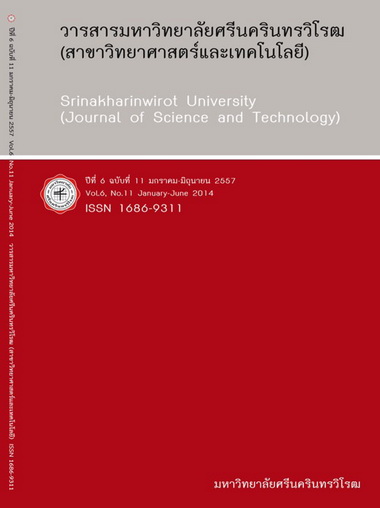การผลิตแท่งเชื้อเพลิงจากวัสดุเหลือใช้ในอุตสาหกรรมการเกษตร และครัวเรือน THE PRODUCTION OF FUEL BRIQUETTES FROM BIO-AGRICULTURAL WASTES AND HOUSEHOLD WASTES
Keywords:
briquettes, charcoal, unused wastes, biomassAbstract
บทคัดย่อ
ในปัจจุบันประเทศไทยมีวัตถุดิบหลายชนิดที่สามารถใช้เป็นแหล่งพลังงานชีวมวลโดยทั่วไป สามารถหาได้จากพืชและสัตว์ ตัวอย่างเช่น ไม้ ฟืน แกลบ ต้นอ้อย ซังข้าวโพด ต้นข้าวโพด และมูลสัตว์ต่างๆ รวมไปถึงของเสียจากโรงงานแปรรูปทางการเกษตรและขยะ เช่น ขยะในชุมชน ขี้เลื่อย เป็นต้น การนำขยะเหล่านี้มาทำการแปรรูปเพื่อใช้เป็นเชื้อเพลิงให้ความร้อนทั้งในครัวเรือนและอุตสาหกรรมโดยกระบวนการแปรรูปชีวมวลหรือของเหลือใช้ ต้องผ่านกระบวนทางกายภาพ ได้แก่ การสับย่อย อัดและทำให้แห้ง ส่วนกระบวนการทางความร้อนและเคมี เช่น การเพิ่มคาร์บอน (Carbonization) การทำให้เป็นของเหลว (Liquefaction) การแปรสภาพเป็นแก๊ส (gasification) และการแยกสลายด้วยความ
ร้อน (Pyrolysis) และกระบวนการทางชีวภาพ ได้แก่ การหมัก แต่กรรมวิธีในการจะนำของเหลือใช้ทางการเกษตร และทางครัวเรือน มาผลิตเป็นแท่งเชื้อเพลิง จะต้องมีการประเมินคุณสมบัติทางเชื้อเพลิงอันได้แก่ ค่าความร้อน ปริมาณสารระเหย เถ้า ความชื้น คาร์บอนคงตัว และต้องมีการประเมินการคัดเลือกรูปแบบ ขั้นตอนและเครื่องมือที่ต้องใช้ในการผลิตแท่งเชื้อเพลิง และการนำไปใช้ประโยชน์ โดยพบว่า ในประเทศไทยมีปริมาณของที่เหลือใช้จากภาคครัวเรือน และภาคเกษตรกรรมในปริมาณที่แตกต่างกัน ตามลักษณะชนิดของวัสดุเหลือใช้ทางการเกษตร ดังนั้นขั้นตอนการผลิตแท่งเชื้อเพลิงในแต่ละพื้นที่ จึงแตกต่างกันทั้งนี้ขึ้นกับความหนาแน่น และความชื้นของการจับตัวกันของเนื้อวัสดุเหลือใช้ นอกจากนี้ มีงานวิจัยเกี่ยวกับการผลิตแท่งเชื้อเพลิงที่นำของเหลือใช้จากภาคอุตสาหกรรมเกษตรและครัวเรือน เพื่อหาวิธีที่เหมาะสมในการผลิตแท่งเชื้อเพลิงให้ได้คุณภาพตามมาตรฐาน ซึ่งแท่งเชื้อเพลิงที่ผลิตได้จาก ฃของเหลือจากอุตสาหกรรมเกษตรและครัวเรือนก่อให้เกิดผลดีในด้านการใช้ทรัพยากรธรรมชาติให้เกิดประโยชน์สูงสุดและเป็นทางเลือกของพลังงานทดแทนที่ดีทางหนึ่งของประเทศไทยได้อีกด้วย
Abstract
At present, there are several types of materials that can be used as biomass energy sources in Thailand. They can be found from both plants and animals such as wood, firewood, rice hulls, sugarcane, corncobs, corn plants, dung (e.g. cow dung, pig dung), and wastes from agricultural processing plants and rubbish (e.g. garbage, sawdust.) To convert these wastes into fuel sources by means of biomass processes, it needs to be done through physical processes
(i.e. chopping, compression, and dehydration), thermal and chemical processes (i.e. carbonization, liquefaction, gasification, and pyrolysis), and biological processes (i.e. fermentation.) Before producing fuel briquettes from agricultural wastes and household wastes, fuel characteristics (heating value, volatile matters, moisture content, and fixed carbon), the selection of procedures and equipment for a fuel briquette production, and how to utilise the fuel briquettes need to be
evaluated respectively. Types and amounts of wastes from agricultural sectors and households vary from one area to another. The process of making fuel briquettes from each area is based on the density and the moisture of the briquette textures. Many studies have been conducted to find suitable methods for producing the industry-standard fuel briquettes from household wastes and those from agro-industry. The production of fuel briquettes from waste materials not only reduces the amount of unused wastes, but it can be used as a good alternative source of energy for the country as well.
Downloads
Downloads
Published
How to Cite
Issue
Section
License
Srinakharinwirot University Journal of Sciences and Technology is licensed Under a Creative Commons Attribution-NonCommercial-NoDerivs 4.0 International (CC-BY-NC-ND 4.0) License, Unless Otherwise Stated. Please Read Journal Policies Page for More Information on Open Access, Copyright and Permissions.



